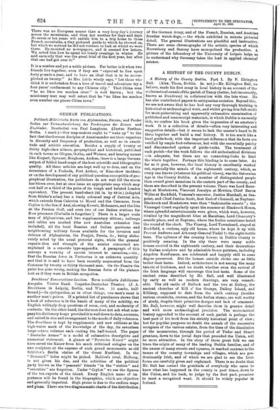A HISTORY OF THE COUNTY DUBLIN.
A History of the County Dublin. Part I. By F. Elrington Ball. (Alex. Thom, Dublin. 5s. net.)—Mr. Elrington Ball, we
believe, made his Brat essay in local history in an account of the ecclesiastical annals of the parish of Taney (better, but incorrectly, known as Dundrum) in collaboration with the late vicar. He has also contributed papers to antiquarian societies. Beyond this, we are not aware that he has had any very thorough training in historical or archaeological work, and whilst giving him full credit for most painstaking and apparently exhaustive examination of published and manuscript materials, in which Dublin is naturally rich, we confess his book gives the impression of an amateur's
work. It is a collection of details—often very interesting and suggestive details—bat it seems to lack the master's hand to fit them together and build a real history. It is too much like a local guide-book, with the important difference that its facts are verified by ample foot-references, but with the essentially patchy and disconnected system of guide-books. The treatment of each parish—for the work follows the old ecclesiastical divisions —is adequate, but there are no connecting-links to bind the whole together. Perhaps this binding is to come later. As far as it goes, however, the local history is excellently worked out, especially the annals of the eighteenth century, which, as every one knows (whatever his political views), was the Saturnian Age in the County Dublin. A number of distinguished people then owned great mansions in the eastern part of the county, and these are described in the present volume. There was Lord Rana- lagh at Monkstown, Viscount Joscelyn at Merrion, Chief Baron Wines at Rockfield, Vanessa's executor, Justice Marshall, at Sea.. point, and Chief Justice Scott, first Earl of Clonmell, at Neptune- Blackrock and Monkstown were then "fashionable resorts " ; the Viceregal Court regularly spent the summer at Blackrock House, where splendid entertainments were given, which were, however, rivalled by the magnificent fetes at Maretimo, Lord Cloncurry's seaside place, and at Neptune, where the frolics sometimes lasted the round of the clock. The Viceroy, Lord Townshend, stayed at Rockfield, a curious, ugly old house, where he kept it up with Provost Andrews and Attorney-General Tisdal to the eight-bottle tune. The ugliness of the country houses in Dublin Comity is positively amazing. In the city there were many noble houses erected in the eighteenth century, and their decorations by Italian sculptors and by admirable fresco painters, including Angelica Kauffulann, are celebrated and happily still to some degiee preserved. But the houses outside strike one as little better than barns. Indeed, architecture is not among the many talests of Irishmen, and we doubt whether even the revival of the Irish language will encourage this lost taste. Some of the ancient ruins described by Mr. Ball, and well illustrated by early as well as modern drawings, are very remark- able. The old castle of Bullock and the two at Dalkey, the ancient churches of Kill o' the Grange, Dalkey Island, and Killiney, supposed to date from the sixth century (besides various cromlechs, crosses, and the bullan stone), are well worthy of study, despite their primitive designs and lack of ornament. Mr. Ball, however, might well describe them in greater detail and with more archaeological precision. The ecclesiastical history appended to the account of each ,parish is perhaps the beat part of his book from the strictly historical point of view ; but for popular purposes no doubt the annals of the successive occupiers of the various estates, from the time of the dissolution of the monasteries, through the period of Tudor and Stuart grantees, down to the jovial days that preceded the Union, will be most attractive. In the story of these great folk we can trace the origin of many of the leading Dublin familiee, and of the names of many streets and squares, in marked contrast to the names of the country .townships and villages, which are pre- dominantly Irish, and of which we are glad to see the Irish forms are carefully given and explained. There is no doubt that Mr. Ball has earned the gratitude of everybody who cares to know what has happened in the county in past times, down to the Union, and his book, to judge by the first part, promises to meet a recognised want. It should be widely popular in Ireland.


























































 Previous page
Previous page